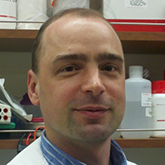To Better Understand Mental Disorders, Researchers Reverse Engineer Schizophrenia “in a Dish”
To Better Understand Mental Disorders, Researchers Reverse Engineer Schizophrenia “in a Dish”

Foundation Support Helps Develop a Stunning New Technology
From The Quarterly, Winter 2015
Imagine if it were possible to observe in real time the biological processes that contribute to schizophrenia or autism, as they occurred. Such magical technology has been under development since 2006, and the Foundation, through its NARSAD Grants, has funded many of the scientists involved in taking this idea from science fiction to research fact. The benefit to patients could be great.
“We now have the ability to study disorders of the nervous system in a new way––by rewinding the development of human neural cells,” says 2012 NARSAD Young Investigator Grantee Alexander Urban, Ph.D., of Stanford University.
 Using skin cells from people with schizophrenia, scientists have grown “iPS cells”–– induced pluripotent stem cells*. All complex life forms begin with one major stem cell: a fertilized egg, explains Fred Gage, Ph.D., of the Salk Institute, a prime mover in the emerging field, a 2013 NARSAD Distinguished Investigator, and Foundation Scientific Council member. “That one stem cell then divides and forms new cells that, in turn, also divide. Even though these cells are identical in the beginning, they become increasingly varied over time,” turning into nerves, muscles, and so on as the organs begin to organize and function together.
Using skin cells from people with schizophrenia, scientists have grown “iPS cells”–– induced pluripotent stem cells*. All complex life forms begin with one major stem cell: a fertilized egg, explains Fred Gage, Ph.D., of the Salk Institute, a prime mover in the emerging field, a 2013 NARSAD Distinguished Investigator, and Foundation Scientific Council member. “That one stem cell then divides and forms new cells that, in turn, also divide. Even though these cells are identical in the beginning, they become increasingly varied over time,” turning into nerves, muscles, and so on as the organs begin to organize and function together.In an exciting breakthrough, neuroscientists learned that they could take ordinary human skin cells and induce them to go “back in time” to the primitive stem cell-like state that preceded their maturation. These cells in turn can be coaxed to re-mature, this time as neurons and astrocytes, the cells that in their billions populate the human brain. Early research in the field focused on figuring out whether the matured versions of neuronal iPS cells really took on the characteristic shapes and functions of adult human cells of the same types.
A landmark paper by Dr. Gage’s team published in Nature in May 2011 showed iPS cells were so much like the real thing, they could actually be used to test theories of how schizophrenia is caused. Most of the clues we have come from study of postmortem brain tissue donated by patients. But because this tissue is no longer alive, it’s different in important ways from tissue that exists in a living brain. Postmortem tissue can show what the brain of a patient looks like after having the illness, perhaps for many years, and often after years of antipsychotic drug treatment. But if schizophrenia, like autism and other neuropsychiatric disorders, has roots in the early development of the brain, the postmortem brain may not be the best place to look for clues.
 It would be ideal to be able to build a cellular “time machine” to observe the early brain biology of people with a mental disorder. In effect, that is what Kristen Brennand, Ph.D., and her colleagues did, using iPS technology to provide a window into the past. Dr. Brennand, now at the Icahn School of Medicine at Mt. Sinai, was awarded a NARSAD Young Investigator Grant in 2012. She was first author on the 2011 Nature paper by Dr. Gage’s team, which used skin cells donated by living schizophrenia patients to grow iPS cells. The iPS cells were then reprogrammed as neurons to show the disease as it developed in real time, as the iPS cells matured.
It would be ideal to be able to build a cellular “time machine” to observe the early brain biology of people with a mental disorder. In effect, that is what Kristen Brennand, Ph.D., and her colleagues did, using iPS technology to provide a window into the past. Dr. Brennand, now at the Icahn School of Medicine at Mt. Sinai, was awarded a NARSAD Young Investigator Grant in 2012. She was first author on the 2011 Nature paper by Dr. Gage’s team, which used skin cells donated by living schizophrenia patients to grow iPS cells. The iPS cells were then reprogrammed as neurons to show the disease as it developed in real time, as the iPS cells matured.Since then, many studies have followed. In 2014 alone, at least five studies conducted by teams led by or including Foundation-supported researchers reported new results on schizophrenia, based on iPS technology. In April, Drs. Brennand, Gage, and colleagues showed that aberrations in patient-derived cells gave rise, during maturation, to aberrant cell migration in the cortex and increased sensitivity to cellular stress caused by oxidation. Previous research has linked unusual cell migration and sensitivity to cellular stress to the development of schizophrenia.
 In October, Drs. Gage, Brennand, and Vivian Hook, Ph.D., 2013 Distinguished Investigator, demonstrated that maturing iPS cells had the ability to secrete message-carrying neurotransmitters in response to stimuli. Prior research found that patient-derived iPS cells secreted too much dopamine, norepinephrine, and epinephrine, compared to cells from healthy controls. This was another sign that iPS cells can shed light on disease pathology.
In October, Drs. Gage, Brennand, and Vivian Hook, Ph.D., 2013 Distinguished Investigator, demonstrated that maturing iPS cells had the ability to secrete message-carrying neurotransmitters in response to stimuli. Prior research found that patient-derived iPS cells secreted too much dopamine, norepinephrine, and epinephrine, compared to cells from healthy controls. This was another sign that iPS cells can shed light on disease pathology.In July and November 2014, researchers used iPS cells from schizophrenia patients to study suspected pathology as it developed in response to the deletion of a segment of chromosome 15 mutations in the DISC1 risk gene. These research teams were led by Guo-li Ming, M.D., Ph.D., and Hongjun Song, Ph.D., from Johns Hopkins University; they are 2010 and 2008 Independent Investigator Grantees, respectively.
Dr. Gage summarizes just how progressive this work is. “Neuroscientists in the past could not have predicted a scenario in which patient-derived, live, functional neurons would be readily available for research,” he says, “and researchers in the future will not be able to imagine a scenario without it.”



